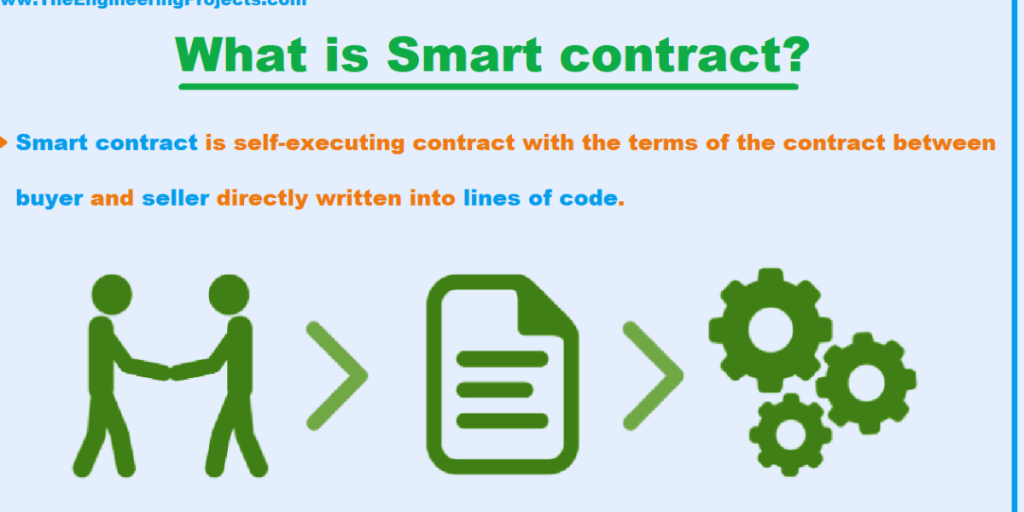What is Blockchain Smart contracts How smart contracts work?

image source google
A smart contract is a self-executing, self-enforcing contract with the terms of the agreement between parties being directly written into code. These contracts are typically deployed and executed on a blockchain or distributed ledger technology, such as Ethereum. Smart contracts enable trustless and automated transactions, eliminating the need for intermediaries like banks or legal systems.
Key characteristics and components of smart contracts include:
- Code-Based: Smart contracts are written in programming languages specifically designed for them, such as Solidity for Ethereum. The code defines the rules and conditions of the contract.
- Decentralized: They run on a decentralized network of computers (nodes) that validate and execute the contract. This decentralization ensures that no single entity has control over the contract, enhancing security and transparency.
- Self-Executing: Smart contracts automatically execute when predefined conditions are met. For example, if you have a smart contract for a bet on a sports event, the contract will release funds to the winner as soon as the outcome is known.
- Immutable: Once deployed on the blockchain, smart contracts are difficult to alter or tamper with. This immutability provides a high level of security and trust.
- Trustless: Parties involved in a smart contract can trust that the code will execute as programmed, without needing to trust a third party. This reduces the risk of fraud or manipulation.
- Cost-Efficient: By eliminating intermediaries, smart contracts can reduce costs associated with traditional contract execution and enforcement.
- Transparency: The terms and execution of smart contracts are recorded on a public ledger, making all interactions transparent and auditable.
Smart contracts have a wide range of applications, including:
- Cryptocurrency Transactions: Smart contracts can be used to automate cryptocurrency transfers, token swaps, and other financial transactions.
- Supply Chain Management: They can track and verify the movement of goods in a supply chain, ensuring transparency and authenticity.
- Voting Systems: Smart contracts can be used to create secure and transparent voting systems, reducing the risk of fraud.
- Real Estate Transactions: Property sales and rental agreements can be facilitated through smart contracts, simplifying the process and reducing the need for intermediaries.
- Insurance: Smart contracts can automatically process insurance claims when predefined conditions, such as a flight delay, are met.
- Tokenization of Assets: Physical assets like real estate or art can be tokenized and traded using smart contracts, increasing liquidity and accessibility.
It’s important to note that while smart contracts offer many advantages, they are not without risks, including vulnerabilities in the code, legal and regulatory challenges, and potential disputes arising from unforeseen circumstances. Therefore, it’s essential to carefully design and test smart contracts and consider the legal implications when using them in real-world scenarios.
How smart contracts work
Smart contracts are computer programs or transaction protocols that function as digital contracts and leverage blockchain technology to execute agreements. They operate through a six-step process, as follows:
- Parties agree to terms and conditions: The creation of a smart contract starts with an agreement between the involved parties. They determine the terms and conditions of the arrangement and the conditions for contract execution.
- The smart contract is created: The transacting parties have various options for creating a smart contract, such as coding it themselves or working with a smart contract developer. The terms of the agreement are translated into a programming language, specifying the rules and consequences, similar to a traditional legal contract.
- The smart contract is deployed: Once the securely designed smart contract is ready, it is deployed to a blockchain. The contract is broadcast to the blockchain, confirming the transaction and making the smart contract live. Once deployed, the contract cannot be revoked or changed.
- Triggering conditions are met: Smart contracts monitor the blockchain or other credible information sources for specific conditions or triggers. These triggers can include verifiable events like a date reached, a payment completed, or an action performed by one or more parties.
- The smart contract is executed: When the triggering conditions are met, the smart contract executes automatically. It performs the predetermined actions, such as transferring funds or registering ownership of an asset.
- The contract result is recorded to the blockchain: The execution of the smart contract is immediately recorded on the blockchain. The network verifies the actions performed by the contract, stores the completed contract as a transaction, and makes it available for review by anyone.
Smart contracts offer benefits such as efficiency, transparency, and security, but they also carry some risks. It is crucial to ensure the security and verification of a smart contract during its creation.
As for use cases, smart contracts can be utilized in various domains, including finance, supply chain management, real estate, and intellectual property. They enable automated and trustless transactions, reducing the need for intermediaries and streamlining processes.
Please note that the provided information is based on the internet search results and may not encompass all aspects of smart contracts.

